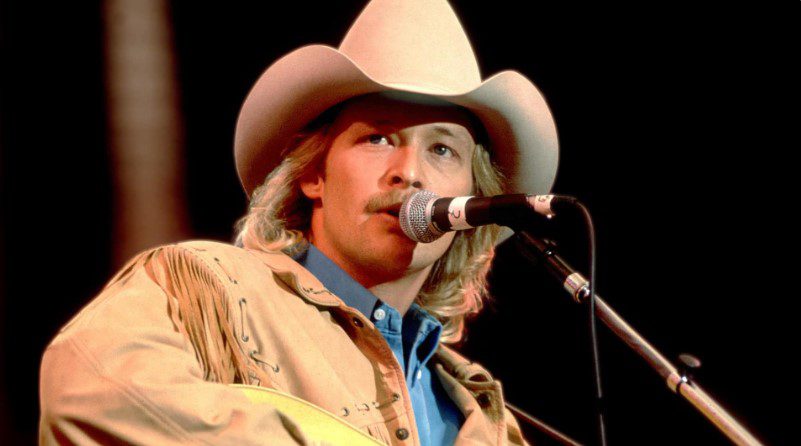
When Alan Jackson released “Tall, Tall Trees” in 1995, fans embraced it as another quintessential piece of his signature sound — a blend of traditional country roots with modern polish. But few listeners realized that the song’s origins stretched back nearly four decades earlier, penned by two of country music’s greatest legends, George Jones and Roger Miller. The story behind the song is more than a simple rediscovery; it’s a testament to how the heart of country music endures through generations of artists who honor its past while shaping its future.
A Song Born from Country’s Golden Era
The year was 1957, and George Jones was already making waves with his honky-tonk voice and heartfelt storytelling. During this period, he teamed up with his friend, the witty and innovative Roger Miller, to write a lighthearted tune that would eventually become “Tall, Tall Trees.” Though the song didn’t gain widespread fame at the time, it showcased the duo’s playful side — a celebration of love and devotion wrapped in quirky metaphors and southern charm.
Jones first recorded “Tall, Tall Trees” as the B-side to his single “Hearts in My Dream.” The recording carried all the hallmarks of classic ’50s country — steel guitars, a steady rhythm, and Jones’s unmistakable vocal twang. While the A-side received modest attention, the flip side remained tucked away, largely forgotten by mainstream audiences. Yet the song’s DNA — its sincerity and humor — would eventually find a new voice decades later.
Roger Miller’s Playful Revival
Fast forward to 1970, and Roger Miller revisited the tune for his album A Trip in the Country. Known for his sharp wit and inventive phrasing in hits like “King of the Road” and “Dang Me,” Miller infused “Tall, Tall Trees” with a breezy, Cajun-inspired swing. His version leaned into whimsy — less honky-tonk grit, more playful swagger — transforming the song into a testament of his unique artistry.
Miller’s take didn’t catapult the track into mainstream fame, but it kept the song alive within Nashville’s inner circles. His recording gave “Tall, Tall Trees” a distinctive second life, marking it as a hidden gem waiting to be rediscovered by the right voice at the right moment. That moment arrived a quarter-century later with a new country superstar who revered both Jones and Miller as musical heroes.
Alan Jackson Discovers a Forgotten Gem
In the mid-1990s, Alan Jackson was riding the crest of country stardom. With hits like “Chattahoochee” and “Gone Country,” he had built a career rooted in traditional sounds that paid homage to legends before him. While compiling tracks for The Greatest Hits Collection, Jackson began exploring older recordings for inspiration — and that’s when he stumbled upon Roger Miller’s version of “Tall, Tall Trees.”
Drawn to its clever lyrics and lighthearted spirit, Jackson decided to record his own rendition, unaware of its full history. Only later did he discover that George Jones, one of his personal idols, had co-written the song decades earlier. Jackson’s reaction was pure reverence — pride in having unknowingly paid tribute to not one, but two of the men who shaped his musical path.
“I didn’t even know George had written it,” Jackson later said in interviews. “When I found out, I thought, well, that just makes it even better.”
A Modern Revival with Classic Country Soul
When Jackson released “Tall, Tall Trees” in 1995, it became an instant fan favorite and a chart-topping success. His version hit No. 1 on the Billboard Hot Country Songs chart, proving that the song’s charm was timeless. Jackson’s interpretation walked a perfect line between the playful rhythms of Miller’s arrangement and the traditional warmth of Jones’s original.
Musically, Jackson’s version bursts with energy — fiddle riffs, steel guitars, and a steady two-step beat that invites listeners to dance. His rich baritone adds depth to the song’s humor, transforming lines about “a mansion on a mountain” and “a garden full of roses” into expressions of pure devotion rather than exaggeration.
The track fits seamlessly within Jackson’s catalog — honest, joyful, and rooted in the values that define classic country music. It feels as if the song had been waiting for him all along.
An Homage to Country’s Continuity
Beyond commercial success, “Tall, Tall Trees” stands as a symbol of country music’s intergenerational storytelling. Few genres so elegantly pass songs from one era to the next, allowing each artist to reinterpret them through their own voice. Jones and Miller planted the seed in the 1950s; Miller nurtured it again in the 1970s; Jackson brought it into full bloom in the 1990s.
This lineage reflects the essence of country tradition — songs don’t just belong to the people who write them, but to the culture that sustains them. When Alan Jackson revived “Tall, Tall Trees,” he didn’t merely cover an old tune; he reintroduced a forgotten masterpiece to millions, ensuring that its legacy would endure for decades more.
The Lasting Legacy of ‘Tall, Tall Trees’
Today, nearly 70 years after it was first written, “Tall, Tall Trees” remains a shining example of how timeless songwriting and heartfelt performance can transcend generations. It’s a song that embodies the joy, humor, and romance that country fans have cherished for decades — a reminder that great music never truly disappears; it simply waits to be rediscovered.
For Alan Jackson, the song became more than a hit — it became a connection between eras, a bridge linking him directly to the very artists who laid the foundation of modern country music. For listeners, it’s a feel-good anthem that still brings smiles and dance-floor memories nearly three decades later.
In every strum and lyric, “Tall, Tall Trees” stands as proof that country music’s roots run deep and strong, nourished by generations of storytellers who continue to shape its enduring sound.